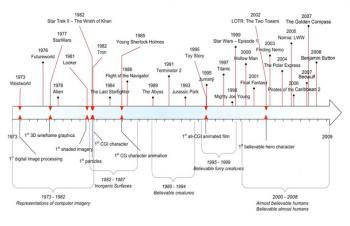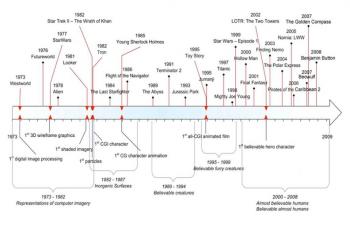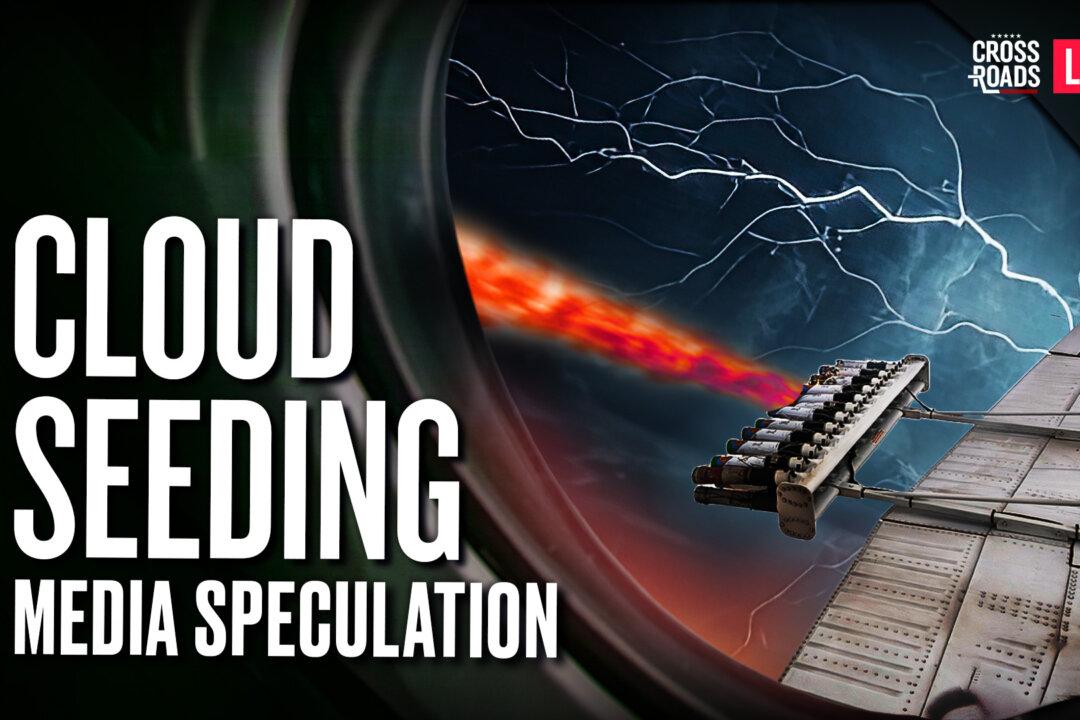The future of technology can be a frightening prospect, or an entertaining endeavor—depending on what it’s used for. As computer technology continues to charge forward, the possibilities in film, information, and entertainment expand with it.
The concept of an “intelligent computer” is becoming more real—the development of computer systems with “cognitive” abilities is even included on the U.S. Department of Defense 2011 budget. The Internet and other information systems are also becoming more advanced with each passing day.
“If Hollywood is right we‘ll either all becomes slaves to it, or they’ll use us as a power source, or they’ll just decide to destroy us all like in ‘Terminator,’” said Duncan Brinsmead, jokingly.
“But I don’t quite see it that way,” he added.
As the principal scientist of entertainment and design software corporation Autodesk, Brinsmead is at the forefront of a different field of technology, and has first-hand experience with what’s in store for the entertainment industry.
“Things are changing as we speak,” said Brinsmead.
Although he couldn’t reveal anything specific, Brinsmead said he sees the next jump in digital entertainment happening in the home theater. In particular, he sees the budding video goggles industry as a major potential.
“The way I see that evolving is something that gives you iMax resolution,” he said.
With the help of built-in gyroscopes, the goggles could allow viewers to look around inside the film. Similar technology can already be found in video games, where a character can turn and see a full world in all directions. Such technology is already being looked at for use in the movie industry, according to Brinsmead.
He added that in addition to the viewer-experience, the real innovation tends to take place behind the scenes. The software that enables special effects, giant blue aliens, and flying houses on balloons directly determines what is possible in film.
Brinsmead said that a lot of people and small development shops want to create films like Pixar, but often don’t realize how many resources it takes to create a digital movie.
Film studios such as Pixar often have full-scale warehouses filled with computers and cooling towers that work as “render farms” to process the huge amount of data needed to create digitally-animated films. Some even have robots that are used to fetch data.
“All that work gets condensed to something that can fit on a data key in your pocket,” said Brinsmead.
“Some people think that making a movie with computer graphics is easier than making a normal movie,” he said. “Computer graphics may be the hardest way of making a movie.”
The concept of an “intelligent computer” is becoming more real—the development of computer systems with “cognitive” abilities is even included on the U.S. Department of Defense 2011 budget. The Internet and other information systems are also becoming more advanced with each passing day.
“If Hollywood is right we‘ll either all becomes slaves to it, or they’ll use us as a power source, or they’ll just decide to destroy us all like in ‘Terminator,’” said Duncan Brinsmead, jokingly.
“But I don’t quite see it that way,” he added.
As the principal scientist of entertainment and design software corporation Autodesk, Brinsmead is at the forefront of a different field of technology, and has first-hand experience with what’s in store for the entertainment industry.
“Things are changing as we speak,” said Brinsmead.
Although he couldn’t reveal anything specific, Brinsmead said he sees the next jump in digital entertainment happening in the home theater. In particular, he sees the budding video goggles industry as a major potential.
“The way I see that evolving is something that gives you iMax resolution,” he said.
With the help of built-in gyroscopes, the goggles could allow viewers to look around inside the film. Similar technology can already be found in video games, where a character can turn and see a full world in all directions. Such technology is already being looked at for use in the movie industry, according to Brinsmead.
He added that in addition to the viewer-experience, the real innovation tends to take place behind the scenes. The software that enables special effects, giant blue aliens, and flying houses on balloons directly determines what is possible in film.
Brinsmead said that a lot of people and small development shops want to create films like Pixar, but often don’t realize how many resources it takes to create a digital movie.
Film studios such as Pixar often have full-scale warehouses filled with computers and cooling towers that work as “render farms” to process the huge amount of data needed to create digitally-animated films. Some even have robots that are used to fetch data.
“All that work gets condensed to something that can fit on a data key in your pocket,” said Brinsmead.
“Some people think that making a movie with computer graphics is easier than making a normal movie,” he said. “Computer graphics may be the hardest way of making a movie.”
Overcoming Boundaries
Directors often struggle with technical limitations. James Cameron wrote “Avatar” in 1995, but had to hold off for technology to reach a stage where the film’s creation would be possible.
According to Richard Taylor, visual director of the 1982 film “Tron,” art changes along with the available technology, but sometimes artists need to create something new in order to make their visions a reality.
Taylor was one of the pioneers of digital animation. In addition to his work on Tron, he also contributed to the special effects for the 1979 “Star Trek” film and designed the Starship Enterprise among other models.
His major breakthroughs in technology began in the 1960s, however, when Taylor was part of a band called “Rainbow Jam.” They would use a type of projection art that overlapped photos and used the additive light to affect the after-image left in the eye to create a moving image.
“The trick with Rainbow Jam was that we learned to play light in really beautiful ways,” he said during a talk in 2007. “We did things that were a lot more subtle than you could ever see in a motion picture.”
When Taylor began his work on “Tron,” he saw what could be done with computer graphics (CG) when the technology was still in its budding phase. As he explains it, “In the state of computer graphics, this was as early as you can get.”
Taylor took the technology a few steps further. Using the lighting tricks from Rainbow Jam, he created a new technique that he dubbed “Candy Apple Backward Neon.” The effect became the signature, glowing look in the film.
Once the film was released, Taylor said he received mixed comments. “Nobody understood how a computer simulation was done because the movie was done so far ahead of its time technically,” he said.
He added, “What you’ll always see in media is that whatever the latest technology or trick is that’s on the air, when you see it for the first time, you think it’s fantastic. Then six months later it’s all over the place.”
During his talk, Taylor also made a prediction: “The 3-D wave is about to hit big time, in a way that you haven’t seen it before.”
Continued on the next page...
Modern Film Technology
Things have changed extensively since the days of “Tron,” and advanced technology is now widely available. “Today, most movies use digital technology extensively,” said Maurice Patel, senior industry marketing manager for Autodesk.
Movies outside the scope of digital animation and low-budget independent films also have professional technology available to them. Editing is done using computer software, such as Avid or Apple Final Cut Pro, according to Patel. Often, even movies shot with film are scanned into computers for post-production work.
In essence, the visual effects enabled by technology help directors to better tell their stories. “This was the case with ‘Jurassic Park’ (digital dinosaurs) and of course, more recently with ‘Avatar,’” said Patel.
According to Patel, visual effects are the biggest drive behind box office results. He cited stats from the Internet Movie Database (IMDB) that the top 20 grossing movies of all time included heavy use of visual effects enabled by technology.
“Movies like ‘Avatar’ would not have been possible without Autodesk technology to design the characters and environments, shoot the virtual production elements, and create the stunning visuals that appeared on the screen,” said Patel.
The most recent breakthrough in film technology is in the area of stereoscopic 3-D (S3D) production. The 3-D effect works by projecting two 2-D images—one for the left eye, and one for the right eye—that creates a 3-D illusion.
Before 2007, the 3-D effect was done manually, using a specialized camera rig, according to Patel.
Although some major developments have been made, “Stereoscopic 3-D is still in its infancy, and there are many technologies that are still being developed to make it easier,” he said.
Although post-editing and color correction is often within budget, S3D and other effects can run up the bill too high for some filmmakers to afford, due to the time it requires. Patel added, “Over the next few years—as with DI—we expect the technology to evolve and become more accessible.”
The current direction of technology is in making things lighter, faster, and easier to use, which will in turn reduce the costs.
The final goal with technology is to enhance the creative process for the artist and to narrow the gap between the artists and their work.
Jaime Labelle, general manager for 3-D software company Pixologic, says technology is something that can eliminate boundaries in creativity. The main application through Pixologic, ZBrush 3, enables artists to sculpt 3-D figures on their computers, as if they were using clay. It was used in films in both “The Lord of the Rings” and “Pirates of the Caribbean” series.
According to Labelle, the goal is to make it so that the technology is nearly non-existent, so that it becomes something that only enhances the artist’s ability to create.
He explains his work as a way to “bridge the gap between art and science,” with the purpose to “have performance without the technology getting in the way.”
Directors often struggle with technical limitations. James Cameron wrote “Avatar” in 1995, but had to hold off for technology to reach a stage where the film’s creation would be possible.
According to Richard Taylor, visual director of the 1982 film “Tron,” art changes along with the available technology, but sometimes artists need to create something new in order to make their visions a reality.
Taylor was one of the pioneers of digital animation. In addition to his work on Tron, he also contributed to the special effects for the 1979 “Star Trek” film and designed the Starship Enterprise among other models.
His major breakthroughs in technology began in the 1960s, however, when Taylor was part of a band called “Rainbow Jam.” They would use a type of projection art that overlapped photos and used the additive light to affect the after-image left in the eye to create a moving image.
“The trick with Rainbow Jam was that we learned to play light in really beautiful ways,” he said during a talk in 2007. “We did things that were a lot more subtle than you could ever see in a motion picture.”
When Taylor began his work on “Tron,” he saw what could be done with computer graphics (CG) when the technology was still in its budding phase. As he explains it, “In the state of computer graphics, this was as early as you can get.”
Taylor took the technology a few steps further. Using the lighting tricks from Rainbow Jam, he created a new technique that he dubbed “Candy Apple Backward Neon.” The effect became the signature, glowing look in the film.
Once the film was released, Taylor said he received mixed comments. “Nobody understood how a computer simulation was done because the movie was done so far ahead of its time technically,” he said.
He added, “What you’ll always see in media is that whatever the latest technology or trick is that’s on the air, when you see it for the first time, you think it’s fantastic. Then six months later it’s all over the place.”
During his talk, Taylor also made a prediction: “The 3-D wave is about to hit big time, in a way that you haven’t seen it before.”
Continued on the next page...
Modern Film Technology
Things have changed extensively since the days of “Tron,” and advanced technology is now widely available. “Today, most movies use digital technology extensively,” said Maurice Patel, senior industry marketing manager for Autodesk.
Movies outside the scope of digital animation and low-budget independent films also have professional technology available to them. Editing is done using computer software, such as Avid or Apple Final Cut Pro, according to Patel. Often, even movies shot with film are scanned into computers for post-production work.
In essence, the visual effects enabled by technology help directors to better tell their stories. “This was the case with ‘Jurassic Park’ (digital dinosaurs) and of course, more recently with ‘Avatar,’” said Patel.
According to Patel, visual effects are the biggest drive behind box office results. He cited stats from the Internet Movie Database (IMDB) that the top 20 grossing movies of all time included heavy use of visual effects enabled by technology.
“Movies like ‘Avatar’ would not have been possible without Autodesk technology to design the characters and environments, shoot the virtual production elements, and create the stunning visuals that appeared on the screen,” said Patel.
The most recent breakthrough in film technology is in the area of stereoscopic 3-D (S3D) production. The 3-D effect works by projecting two 2-D images—one for the left eye, and one for the right eye—that creates a 3-D illusion.
Before 2007, the 3-D effect was done manually, using a specialized camera rig, according to Patel.
Although some major developments have been made, “Stereoscopic 3-D is still in its infancy, and there are many technologies that are still being developed to make it easier,” he said.
Although post-editing and color correction is often within budget, S3D and other effects can run up the bill too high for some filmmakers to afford, due to the time it requires. Patel added, “Over the next few years—as with DI—we expect the technology to evolve and become more accessible.”
The current direction of technology is in making things lighter, faster, and easier to use, which will in turn reduce the costs.
The final goal with technology is to enhance the creative process for the artist and to narrow the gap between the artists and their work.
Jaime Labelle, general manager for 3-D software company Pixologic, says technology is something that can eliminate boundaries in creativity. The main application through Pixologic, ZBrush 3, enables artists to sculpt 3-D figures on their computers, as if they were using clay. It was used in films in both “The Lord of the Rings” and “Pirates of the Caribbean” series.
According to Labelle, the goal is to make it so that the technology is nearly non-existent, so that it becomes something that only enhances the artist’s ability to create.
He explains his work as a way to “bridge the gap between art and science,” with the purpose to “have performance without the technology getting in the way.”








